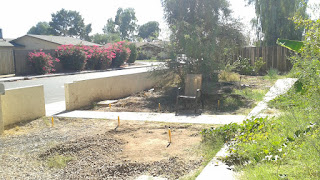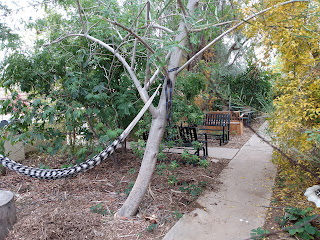2021 Retrospective
I'm really grateful for Charlie's and Lucy's help this year, and for the opportunity to watch and participate in their projects on site. We have more than ever to "show and tell" at the end of 2021. And I think we've also made lots of "productive mistakes" (the kind we can learn from).
| We had opportunities apply new (to us, anyway) gardening methods1,2 in Lucy's new garden bed, Charlie's grow boxes, and in managing the banana patch and the walking labyrinth. |  |
 |
 |
We experimented with low water use irrigation methods5, including ollas and wicks.
 |
 |
| We practiced some new methods for cycling nutrients, including the Johnson-Su bioreactor, windrow composting, static composting, and home-grown plant-based liquid fertilizer6. |
 |
 |
 |
 |
 |
We added other physical elements to the site, including expanded irrigation, arbors, outdoor sitting areas, a temporary chicken pen I'm using as you would a chicken tractor, and as usual, more trees.
 |
 |
 |
 |
 |
 |
In addition to the physical elements we've added to the site, we've made progress this year on some non-physical assets, including a site design upgrade, seasonal surveys to record the seasonal state of the plants every 10 days, and I've been informally studying7,8 what I suppose you could call "complementary economics" (economic systems that can be embedded as a complement within the standard economy).
2022 Prospective
Some things I'm looking forward to in 2022 are expanding the food forest, fertilizing our plants with local and resident nutrients, growing trees and bushes from cuttings, foresting the labyrinth, gardening around one of the olives, hay mulching, creating a kitchen garden in the northwest, and possible experimenting with ponds.
- Jason
Throwback - Five Years Ago
Here are some before / after photos from the east side of the site. The "before" photos on the left are from Oct 2016; the "after" photos are from Dec 2021 (also, there's an updated video tour).
 |
 |
 |
 |
References
1. Charles Dowding and Stephanie Hafferty, No Dig Organic Home & Garden (Hampshire: Permanent Publications, 2017)
2. Ruth Stout, Gardening Without Work (Battleboro: Echo Point Books & Media, LLC, 1961)
3. Martin Crawford, Creating a Forest Garden (Cambridge: Green Books, Ltd, 2010)
4. Patrick Whitefield, How To Make A Forest Garden (Hampshire: Permanent Publications, 2002)
5. David A. Bainbridge, Gardening With Less Water (North Adams: Storey Publishing, 2015)
6. Leopold Stocker Verlag, Sepp Holzer's Permaculture (White River Junction: Chelsea Green Publishing, 2004)
7. Bernard Lietar and Jacqui Dunne, Rethinking Money (San Francisco: Berret-Koeler Publishers, Inc, 2013)
8. Marjorie Kelly and Ted Howard, The Making of a Democratic Economy (Oakland: Berret-Koeler Publishers, Inc, 2019)





